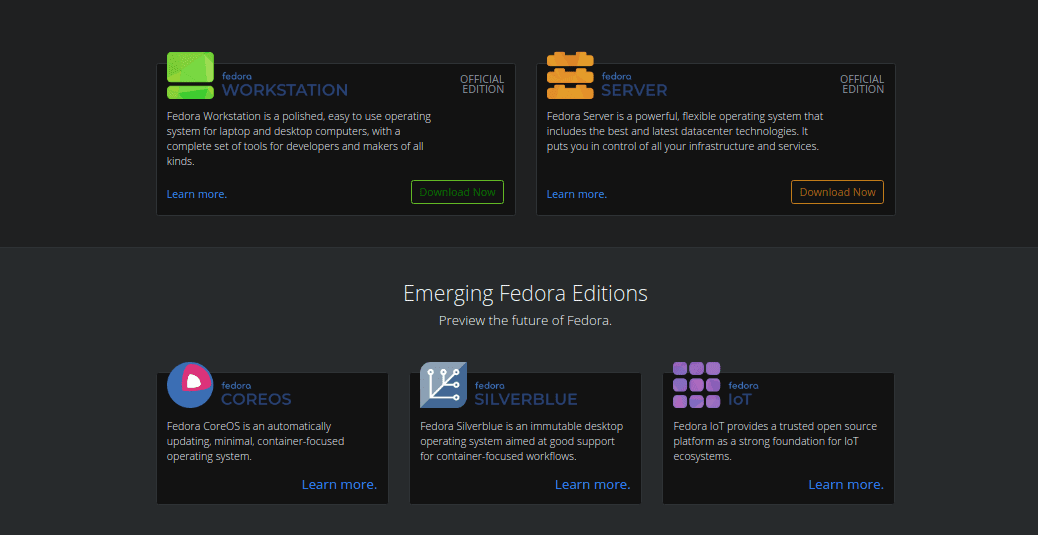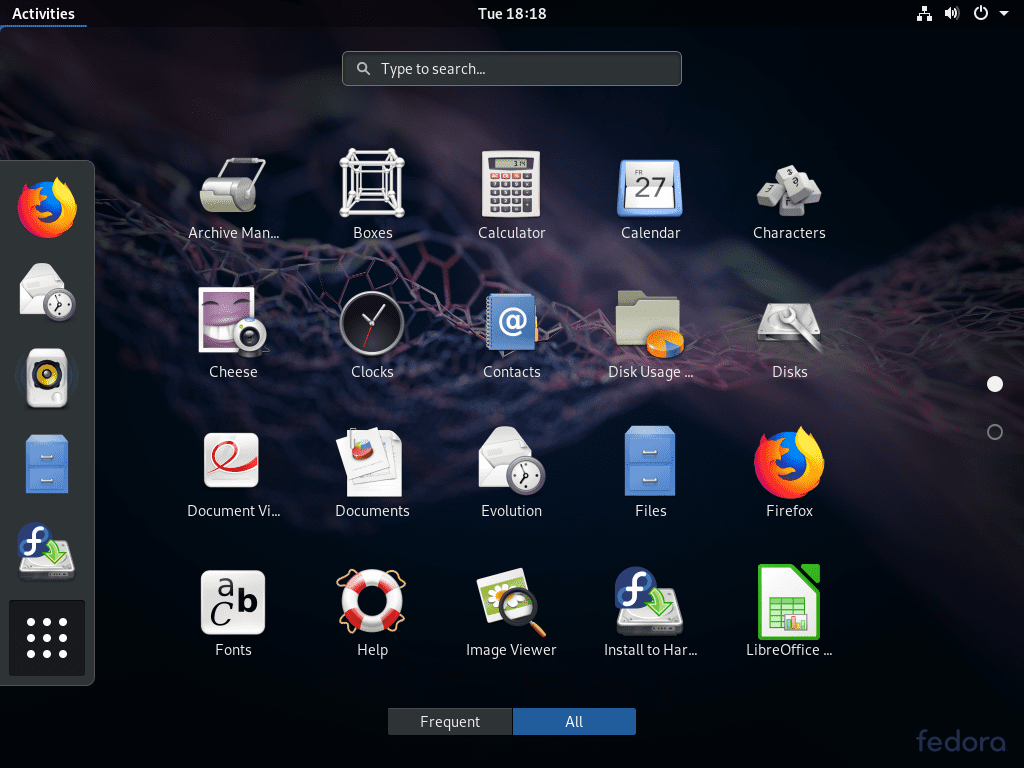After Fedora 32 Beta was deemed unready for release last week during the initial Fedora 32 Beta “Go/No-Go” meeting. However, just 24 hours later, the Fedora developers reconvened and determined that all bugs had been successfully addressed. As such, the beta release is now scheduled for release on Tuesday, March 17, 2020.
If the remaining schedule goes as planned, the final production version of Fedora 32 is scheduled for release on April 21, 2020. Should issues arise or more bugs are found during the Fedora 32 beta phase, the release date will be pushed back to April 28, 2020.
About Fedora
Fedora (aka Fedora Linux) is a Linux distribution that is the upstream source of Red Hat Enterprise Linux (RHEL) and sponsored by a variety of companies, but primarily by Red Hat Incorporated. The community-supported Fedora Project develops and maintains Fedora.
As of Fedora 30, there are five different editions of Fedora are available for download:
- Fedora Workstation – edition of Fedora focused on desktop computing.
- Fedora Server – edition of Fedora focused on servers.
- Fedora CoreOS – edition of Fedora focused on cloud computing.
- Silverblue – edition of Fedora focused on an immutable desktop and delivered in images created by utilizing rpm-ostree. In addition to immutability, other benefits of Silverblue are speed, security, and atomic updates.
- Fedora IoT (Internet of Things) – edition of Fedora focused on IoT devices like an IoT internet gateway device, Rasberry Pi, and IoT sensors endpoint device, etc.
Fedora has a page hit ranking of nine on distrowatch.com and enjoys an 8.45/10 average visitor rating. As of February 2016, Fedora has an estimated 1.2 million users, including Linus Torvalds (as of 2015), creator of the Linux kernel.
New Features in Fedora 32
Changes and new features abound in Fedora 32. Let’s review some of them.
- Binutils upgraded to Binutils 2.3
- DNF (Dandified yum) improved (for better, more accurate counting of Fedora users)
- GCC 10 compiler upgraded
- Glibc upgraded to Glibc 2.31
- Python upgraded to Python 3.8
- Python 2 removed/retired
- Ruby upgraded to Ruby 2.7
- PHP upgraded to PHP 7.4
- MariaDB upgraded to MariaDB 10.4
- GNOME upgraded to GNOME 3.36 (Fedora Workstation 32)
- And many more
For a list of all changes introduced in Fedora 32 Core, refer to the official Fedora 32 Changeset.
Conclusion
Like most Linux enthusiasts, we here at FOSS Linux are eagerly awaiting the Fedora 32 Beta release today anytime. Rest assured that we will perform an installation as soon as possible. Keep checking fosslinux.com for updates and possibly a review.
Kudos to the Fedora Project developers for adhering to and meeting their release schedule despite the current COVID-19 pandemic gripping the world right now.




12 comments
“New features”…. basically just software version updates? Anything exciting for a “normal” non-dev user? Also I use KDE Plasma, so Gnome doesn’t interest me, and you don’t cover other spins.
I understand what you’re saying, but I can only cover what’s included in the particular distro’s release notes. Also, please note we did cover the release of KDE Plasma 5.18 last month.
However, your comment does pique my interest. Can you please provide a list of topics in response to this to let us know what content you would like us to cover? It would really be doing FOSS Linux a solid.
Thanks for your comment and I look forward to your response.
Thanks,
Travis
[[tl;dr Skip to the last paragraph]]
For your average desktop user, the packages you mentioned are pretty ho-hum.
Binutils – command line stuff written by supernerds for nerds
DNF – software installer that was improved “for better, more accurate counting of Fedora users” – I can do that on my desktop pretty easily. Watch. 1. Done.
GCC – A program that makes programs. Zzzzz.
Glibc – More background software used by other software. Yo dawg.
Python – Programming language for snakes
Python 2 – Programming language for old snakes
Ruby – Programming for jewelers
PHP – Goodness. How many programming languages does one person need?
MariaDB – A database. What could be more exciting?
I was going to suggest you could go through the changes that are coming in Gnome. You did link to an article about what’s new in Gnome 3.36. That should be interesting. Let’s see…
“What’s new in GNOME 3.36
As you would’ve guessed from the news title, this update to GNOME is packed with new features, so let’s have a look at some of them. [[Sweet! I can’t wait!!!]]
When you open your computer after updating, you’re going to be greeted with an improved login screen that’s much more user-friendly, functional, and simpler…”
And then a screenshot of the login screen. Yes it’s different, but it’s just a password prompt. I don’t see any new features that make it more functional. Maybe they took away features and now it’s simpler and thus more user-friendly? No biometrics or MFA?
Anyway, I stopped reading the other article there (well, not really, but you get the idea). I hope I’m not coming across too harshly. Incremental software updates are booooooring. That’s one thing I’ve enjoyed about Fedora. I used Slackware back in the day, and enjoyed it at the time, but upgrades were pretty much “backup, wipe clean, reinstall, restore from backup” so I ended up doing the ./configure && make && make install dance over and over. Installing XFree86 and then upgrading to X.org was a nightmare. Eventually, a new version of glibc was out and I was at a point of being forced to upgrade, so I scrapped the system and used a Windows laptop for several years. That was OK. Then I built a desktop on Fedora 16 or 18 (I forget)…8 years ago or so and have been upgrading it ever since. Skipped versions, upgraded once to a new HDD and then to SSD. It hasn’t always been perfect but it’s still going and I’m looking forward to upgrading from F31 to F32 soon.
That’s enough criticism. Let’s be constructive. What can you do? You might get a Fedora Bugzilla account and look for bugs in F31 that are fixed in F32, perhaps in the version of Gnome or LibreOffice or Firefox or something else that comes with F32 that an average user would..use. Maybe browse some forums or youtube videos of people using F30 or F31 or earlier and complaining about something that might be fixed in the latest version. Is there a better gaming experience? Better security? Does the Gnome password Seahorse manager still suck? (I’m not holding my breath.) Remember that Fedora is a desktop operating system and the desktop audience generally doesn’t have the same interests as a server administrator. Also keep in mind that a boring release is a good release.
Hi Andy,
I like your writting style. Do you blog/write on foss ? If not you should consider it.
Looking forward to this!….have been with Fedora Linux?…..since 2002!….& I have watched this distro “grow up” into a great distro/environment for developing & coding!….can’t wait to finally install it!!
Don’t wait, Knight Hawk. Download it now. I did. It’s installing as a VM on my system as I pen this reply.
Give it a whirl and let us know how you like it.
Thanks!
Travis
One of the major improvements is that you now get the major Inkscape upgrade (1.0), which is fantastic.
Also, Fedora 32 feels really fast and polished and beautiful. This is a great version.
Of course, it will take a bit of time for all the Gnome extensions to be up to date, so for my production platform I wait for the April version.
Hey there, you have some mistakes and stuff.
You called Linus Torvalds “Linux Torvalds”, then in the next paragraph you repeated yourself twice, and above that when you talk about Fedora Workstation, you said it was for cloud computing, instead of it being for desktop computing.
We appreciate your effort in taking the time to report the typos. All fixed now. Thanks.
Seems like the release date have been pushed to april 28. preferred release date is 21. but current release date is 28.
Been using Fedora workstation for a few years. stable, fast, vast software repositories and gaming on Wine + DXVK is the best. Thanks!
Fedora is the most stable distro of all time, the ideia of this distro is productivity, so do’nt wait much design improvements.